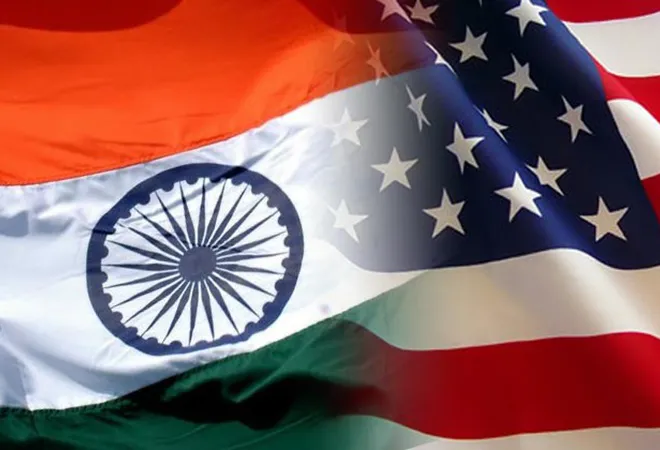
Later this month, Defence Minister Rajnath Singh and External Affairs Minister S Jaishankar will convene with their American counterparts – Secretary of Defence Mark Esper and Secretary of State Mike Pompeo, for the second edition of the US-India 2+2 Ministerial Dialogue. Slated for 18 December in Washington DC, the meet will build on the inaugural round held in September 2018 between then-Ministers of External Affairs and Defence Sushma Swaraj and Nirmala Sitharaman, with Secretary of State Mike Pompeo and then-Secretary of Defence James Mattis.
This round of the consultative dialogue, will be the first since the resignation of staunch India supporter Secretary Mattis and Indian Prime Minister Narendra Modi’s re-election in 2019 – which led to a change of guard at the ministries of defence and external affairs. Additionally, as the impeachment inquiry into US President Donald Trump’s alleged strong-arming of Ukraine for political favours in exchange for military aid continues, Secretary Pompeo is increasingly coming under fire. As America’s chief diplomat, questions over what, when, and how much, did Pompeo know of Trump’s actions have been feeding calls for him to testify at the Capitol Hill. As a result of the clamour, Pompeo seems to have “one foot out the door”, with plans for a Senate run from Kansas.
Regardless of these changes and uncertainties, the consultative dialogue is expected substantially build on the defence dynamic between New Delhi and Washington.
Authorising the next round of maritime defence procurements
Under Trump, the nature of US arms exports to India seems to have assumed a singular focus on exporting Mahanian thinking – towards the aim of “socialising” India into an active naval role in the Indian Ocean and the Indo-Pacific at-large. Hence, at the upcoming ministerial dialogue, transfer of crucial naval platforms is expected to be furthered.
Recently, the US State Department cleared the sale to India of up to thirteen MK 45 5 inch/62 caliber (MOD 4) naval guns and three thousand five hundred D349 Projectile, 5”/54 MK 92 MOD 1 Ammunition at an estimated cost of USD 1.0210 billion. The clearance’s press notification notes the proposed sale to “support the foreign policy and national security of the United States by improving the security of a strategic regional partner.” Thus, while the long-drawn process of procuring the naval guns has only begun, the timing of the clearance – in the run up to the consultative dialogue – reflects the prioritisation of the transfer.
Another proposed sale is that of 24 multi-role MH-60 Romeo Seahawk maritime helicopters to India at a cost of USD 2.6 billion. Cleared by the State Department in April, the much-touted submarine hunter helicopters were sought after for nearly a decade by the Indian Navy. As per the press notification, these helicopters would give India the “capability to perform anti-surface and anti-submarine warfare missions along with the ability to perform secondary missions including vertical replenishment, search and rescue, and communications relay.” An agreement over these helicopters is reportedly the “closest to conclusion”, and an announcement can be expected at the 2+2 dialogue.
In addition, the Indian Defence Ministry’s Defence Acquisition Council (DAC) recently approved the procurement of six additional Boeing P-8I maritime surveillance and anti-submarine aircraft. With eight of those already in service, and another four due in 2020-21, India is already the second largest operator of the P-8 after the US itself. The additional procurement is in line with developing “maintenance facilities for the fleet in the Andaman Islands and Goa to give the Indian Navy flexibility in deploying these aircraft where they are needed the most.” Once again, the clearance of the procurement – in this case from the Indian end – in the run-up to the consultative dialogue, affirms the increasing congruence between New Delhi and Washington over the former’s evolving role in the Indian Ocean.
Actualising the US-India Defence Technology and Trade Initiative (DTTI)
The upcoming dialogue is also expected to witness finalisation of the Industrial Security Annex (ISA). At last year’s inaugural 2+2 dialogue, the ministers had expressed “their readiness to begin negotiations” on inking ISA that “would support closer defence industry cooperation and collaboration.” Once signed, ISA would enable US arms manufacturers to transfer sensitive technologies to entities beyond the Indian public sector, to even corresponding partners in the private sector.
Particularly, the ISA will go a long way in actualising the DTTI – set up in 2015 under the Barack Obama administration to move New Delhi and Washington from a traditional “buyer-seller” dynamic to one of co-production and co-development. In October this year, during Under Secretary of Defence for Acquisition and Sustainment, Ellen Lord’s visit to New Delhi, the two sides signed a ‘Statement of Intent’ outlining DTTI “deliverables in the near, medium and long terms.” They also outlined the shared commitment to “continually engage” and “facilitate cooperation between the defence industries of both nations.”
Even without the ISA, some ancillary projects have taken off with Indian partners – to some benefit for the Modi dispensation’s ‘Make in India’ initiative. For instance, Tata Advanced Systems Limited (TASL) and Lockheed Martin employ 500 people to locally produce two dozen aircraft empennages per year. Similarly, at a facility in Hyderabad, TASL and Boeing employ up to 350 skilled workers to produce helicopter fuselages. Boeing has strengthened its supply chain with over 160 domestic partners to support subassembly production of aft pylon and cargo ramp components of heavy-lift helicopters.
Although these projects come under the broader essence of the DTTI, they are largely “offset obligations” projects towards India’s acquisition of advanced American platforms like the Apache AH-64E multi-role combat helicopters, the C-130J Super Hercules transport aircraft, and the Chinook CH- 47F (I) heavy lift, tandem rotor helicopter.
The ISA is an important precursor for the complete actualisation of the DTTI, which includes “build to print” joint projects on air-launched unmanned airborne systems (UAS), lightweight small arms technology, and innovations in the field of intelligence, surveillance, targeting and reconnaissance (ISTAR). Apart from connecting partners across Indian and American private and public sectors, the ISA institutes safeguards “to ensure that the information is protected under Indian law.”
Actualising US-India DTTI would give a fillip to the ‘Make in India’ projects in the defence sector “collectively worth over Rs 3.5 lakh crore” being “either stuck or still meandering through different stages, without the final contracts to launch production being inked.”
Delineation of strategic ties from trade tensions and challenges on the Hill
Under Trump, US-India ties have been marred with tensions on the trade front. In negotiating a trade deal, some contentions – like over access of US dairy products in face of Indian sensitivities on blood-meal and Indian price caps on pharmaceutical imports, have proven to be the proverbial ner in the works. In addition to prolonging the negotiations – now in its second year, some of these have now been excluded from the purview of the talks. For instance, the contention over dairy products has reportedly been excluded from a partial trade package – which is seen as a “steppingstone” towards resolving the broader trade disputes.
American partisanship on India is another issue challenging the fundamental core of the US-India partnership.
Reflected in the US Congress and successive post-Cold War administrations, the bipartisan support for stronger US-India ties stands underpinned by the highly affluent Indian diaspora in the US and the shared commitment on liberal democratic values between the largest and the oldest democracies. Following the Modi government’s abrogation of Article 370 and the ensuing communications blackout in Kashmir, however, the US Congress has questioned India’s commitment to the convergence on shared values. This was evident at October’s Congressional hearing on human rights in South Asia, where bipartisan support for India became a sticking point as Democrats rallied against Trump’s ambivalence on the communications lockdown in Kashmir, and Republicans sought to dampen criticism by making a case against a values-centric US foreign policy. Subsequently, the Democrats have >also introduced two House Resolutions (one by Rep. Rashida Tlaib and another by Rep. Pramila Jayapal) on urging India to end the communications blackout and preserve religious freedom.
To the credit of the Trump administration, however, strategic ties have progressed largely unhindered. The same has been apparent in the delivery of arms platforms as agreed in prior negotiations and force interoperability being graduated to the next level with the recent India-US tri-service military exercise. This has coalesced due to the growing convergence between India and the US on their respective Indo-Pacific strategic calculi.
Importantly, from the standpoint of bilateral ties, unhindered progress has also been due to the US-India dynamic moving away from the erstwhile approach of depending on the personal chemistry between political leaders. Through the early 2000s and shortly thereafter, overt reliance on the dynamics between the respective heads of government was crucial “to wade through conflictual issues such as the US’ opposition to India’s nuclear programme.”
As the bilateral relationships assumes greater dynamism, the US-India trajectory is now animated on governmental, bureaucratic, and military levels. Hence, in the run up to the second US-India 2+2 ministerial dialogue, it is important to recognise such platforms as the future drivers of the US-India partnership. As for the emergent challenges – emanating from Trump on trade and the US Congress on Kashmir – the delineation of strategic ties is set to be the biggest takeaway from this upcoming high-level engagement.
The views expressed above belong to the author(s). ORF research and analyses now available on Telegram! Click here to access our curated content — blogs, longforms and interviews.




 PREV
PREV


